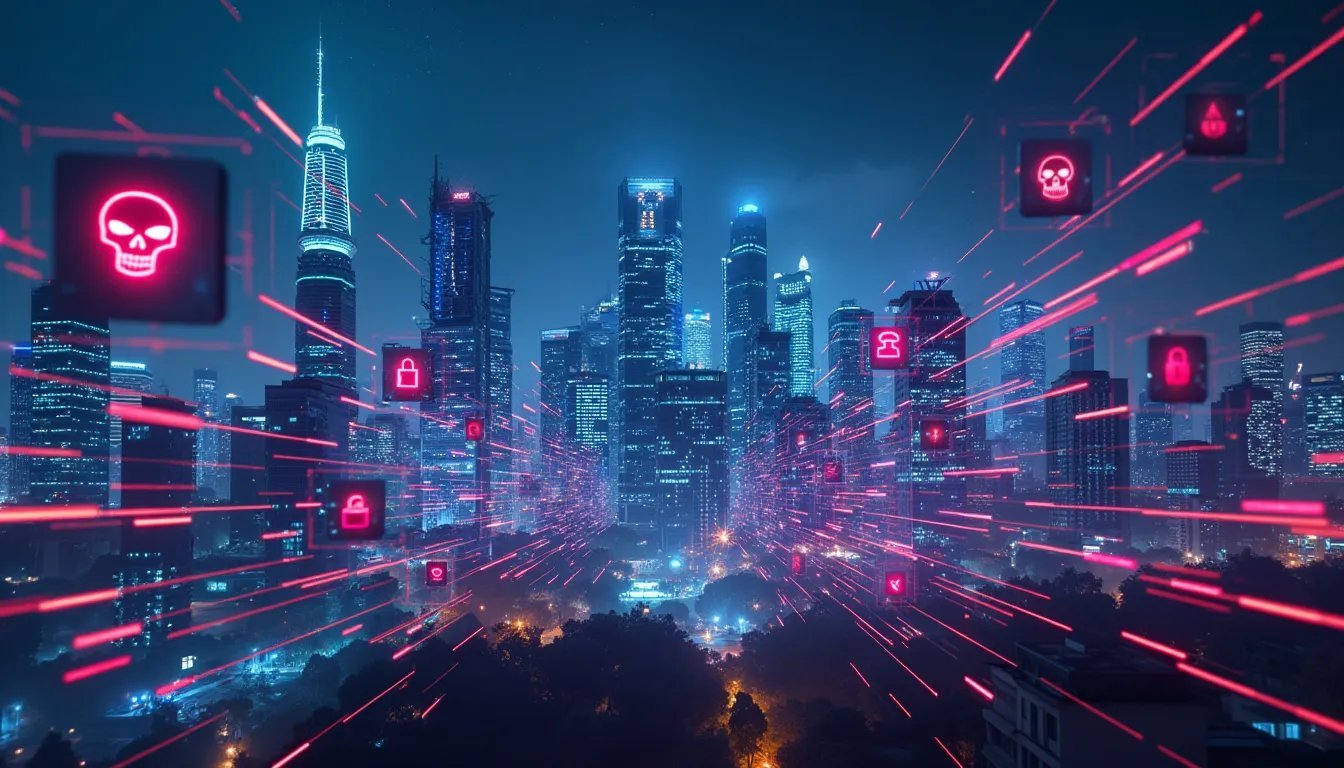Top Cybersecurity Threats in 2024: Key Risks and Insights
Research from the University of Maryland reveals a staggering 92 cyberattacks unfold every hour—an attack every minute!
In 2023, Verizon published a report on data breaches stating that about 74% of cyber breaches came from human mistakes. This fact shows how important it is to be aware of future cybersecurity dangers. As hackers get more intelligent, companies face more risks, which can cause significant money losses and data theft.
We’re looking at the top cybersecurity threats for 2024, such as ransomware, phishing, and AI-driven attacks. This article will show how to protect your systems and reduce cyber risks. Soon, ransomware attacks could happen every two seconds, so it’s vital to stay ahead of these threats.
Cybersecurity in 2024 will significantly impact how you do business. Being aware and educated is essential. We will cover the most significant threats and how to keep your company safe.
Critical Strategies for Enhanced Security
Cybercriminals are getting smarter, making digital threats more common and damaging. One famous trick is social engineering. Here, crooks pretend to be bank staff to trick people. Companies must fight back with tech like multifactor authentication and teach their staff.
Educating everyone about these scams is vital in fighting attacks. Teaching staff about social engineering helps them spot and stop these tricks. Creating a secure-minded culture in your company means encouraging people to report problems and keep software updated.
Working with outside companies brings extra risks, like data leaks from third-party services. It is essential to check these partners’ security closely to avoid trouble. In cloud computing, watch out for data leaks and unauthorized access. Working together with cloud providers can make your data safer.
Strengthen your defenses, teach your team, and observe your partnerships. Facing the future means staying alert, flexible, and dedicated to cybersecurity.
Adapting to the Dynamic Cybersecurity Landscape
The world of cybersecurity is changing fast as new threats emerge, changing how organizations handle security. Every day, we see new cybersecurity threats, bringing fresh challenges for businesses to keep their information safe.
In 2022, 10% of data breaches were due to ransomware, showing how serious this issue is. This year, the ransomware attack’s cost hit an alarming $1.85 million on average.
Cybercriminals are getting more frequent and creative with their attacks. They’re using more brilliant social engineering, making it harder for people to spot an attack. Experts predict that by 2031, ransomware attacks could happen every two seconds.
Plus, the growth of artificial intelligence creates new risks, like the misuse of big language models for spreading false information and launching cyberattacks.
The industry is adapting to these changes. Cisco’s purchase of Splunk shows a shift towards focusing on data for security solutions. Yet, companies like Rapid7 are reducing staff, highlighting the industry’s ups and downs. Security leaders are merging tools to strengthen security measures, moving towards platforms with a complete view of security status.
Businesses are fighting against cybersecurity threats under the guidance of Chief Information Security Officers (CISOs). They are now focusing on results. They consider how well they can see into their networks, access data remotely, and how much they depend on their tools.
These steps are crucial for robust cybersecurity defenses. Cybersecurity moves in cycles of new ideas and merging technologies, driven by economic changes. Companies must keep up with trends to protect their systems and data well.

The Weakest Link in Cybersecurity
Humans play a big part in cybersecurity. Every day, people make mistakes that pose risks. Knowing about these risks is critical to making things safer.
Impact of Human Negligence on Security
Most cybersecurity issues start with human mistakes. Common problems include:
- Weak passwords: People often choose easy or repeated passwords, like names or birthdays.
- Weak authentication: Skipping steps like multifactor authentication puts data at risk.
- Delivery errors: Mistakes in sending info to the wrong person can leak valuable data.
- Misconfigurations: Not changing default passwords can invite hackers in.
- Social engineering attacks: Cybercriminals use tricks to make people give out important info.
- Credential attacks: Hackers use stolen passwords to break into accounts.
Mitigation Strategies for Human Risk
Organizations need good plans to reduce human risk. Effective strategies include:
- Cybersecurity awareness training: Learning about threats like phishing helps boost security.
- Strong password policies: Use strong passwords and management tools to reduce risk.
- Multifactor authentication: Adding extra security steps helps keep data safe.
- Regular training sessions: Ongoing training and practice with phishing simulations enhance alertness.
- Technological assistance: Tools for monitoring and response can prevent errors from causing harm.

Phishing Attacks: A Persistent Threat
Phishing attacks are a significant risk online. They trick people using human psychology, and knowing how to fight them is critical. Many phishing attacks exist, each with tricks for stealing info.
Types of Phishing Attacks
Knowing the various phishing types helps in avoiding them. Let’s look at some:
- Email phishing: This common type sends fake emails that look real.
- Spear phishing: These attacks target specific people with personal details to seem more believable.
- Smishing: This method uses text messages to get people to click the wrong links or share private info.
- Whaling: It uses big targets, like company leaders, for essential data.
- Vishing: This involves phone calls to trick people into giving away secrets.
Best Practices to Combat Phishing
To fight phishing well, companies need strong plans. Here’s what works:
- Doing phishing simulations helps employees spot phishing tries.
- Using multi-factor authentication (MFA) makes accounts much safer.
- Teaching employees about new fraud tactics and phishing methods is vital.
- Setting up email filters can stop phishing emails before they harm.
- Making it easy to report weird emails builds a watchful workplace.
By learning about phishing and following these tips, your organization can fight off these ongoing dangers.

Ransomware: The Growing Epidemic
Ransomware attacks have surged, posing severe threats. Cybercriminals are using advanced techniques to compromise systems. They exploit weaknesses and demand ransoms to return critical data. The healthcare sector has seen a spike in these attacks, increasing the frequency and sophistication.
Statistics on Ransomware Attacks
Recent stats highlight the seriousness of ransomware. In 2023, there were over 420 million attacks on critical infrastructure, which averages about 13 attacks every second. Healthcare organizations are now prime targets, with more than one in three facing attacks.
In the U.S., over 600 healthcare entities and about 18 million patient records were breached in 2020, costing the sector nearly $21 billion.
Effective Ransomware Protection Strategies
Ransomware can only be defeated with robust protection. Organizations must employ a layered cybersecurity method. Among them are:
- Regular data backups using a 3-2-1 strategy (three copies of data on two different media with one off-site copy)
- Employee training to spot phishing attempts, which often lead to ransomware
- Advanced email filtering tools to block malicious emails
- Network segmentation to limit the spread of any breach
- Encrypting sensitive data to keep it safe from unauthorized access
Prioritizing these methods can significantly reduce risks from ransomware. The goal is to ensure organizations remain strong against major threats in 2024.

AI-Powered Threats: A New Era of Cyber Attacks
Artificial intelligence (AI) is changing cybersecurity, creating significant risks called AI threats. Cybercriminals use AI for more ingenious attacks, like phishing and deepfakes. Knowing about these dangers helps us fight them better.
Understanding AI-Driven Attacks
AI attacks are becoming more common, affecting many areas. The market for AI cybersecurity was $15 billion in 2021. By 2030, it’s expected to hit $135 billion, an 800% increase. The use of AI in cybersecurity is becoming increasingly important.
- AI lets hackers automate attacks, making them harder to spot.
- It helps crack passwords quicker, making breaches easier.
- Deepfake tech uses AI for fake videos and voices.
- Attackers use AI to mess with data, making it hard to find threats.
- Still, AI helps security tools spot actual attacks faster, reducing mistakes.
Security teams use AI to catch phishing attempts. It’s great at analyzing data to respond to threats quickly. With fewer cybersecurity workers available, AI helps cover the gap, speeding up the creation of new security tools.
As AI improves, staying alert and ready is crucial. Staying updated and investing in good cybersecurity are vital in defending against AI threats.

The Dark Web: A Hub for Cybercriminals
The dark web is a secret part of the internet where anonymity reigns. Cybercriminals use it to trade stolen data, hacking tools, and illegal items. They often pay with Bitcoin, making their actions hard to trace. The dark web’s mix of secrecy and crime greatly worries cybersecurity experts.
Role of the Dark Web in Cybercrime
The dark web provides a space for cybercriminal activities to grow. You can find stolen credit card information, bank data, malware, and hacking tools there.
Cybercriminals also share stolen identities to hijack accounts. They also use forums to exchange tips on illegal activities, which helps them learn and share helpful hacking information.
Strategies for Dark Web Monitoring
Organizations fight dark web threats with dark web monitoring. They scan the dark web for leaked company information, such as passwords or data breaches, and use special tools to get alerts about possible leaks.
As a result, more extensive problems can be prevented before they worsen. Teaching about phishing and using solid passwords also helps keep them safe.

Cloud Security Vulnerabilities
Moving businesses to the cloud means we must focus on security more than ever. Problems can come from mistakes in setup, not correctly managing who has access, and the risk of insider threats. All organizations need to know about these issues to keep their data safe.
Common Cloud Threats
There are several threats to cloud security we all should know about. Here are the main ones:
- Cloud misconfigurations can expose sensitive info because of different default settings from various providers.
- Identity and Access Management (IAM) issues can lead to weak access controls due to complex user roles.
- Insider threats come from employees who might accidentally or purposely leak data.
- Shadow IT is a risk when staff use cloud apps without approval.
- Zero-day exploits hit software flaws before they’re fixed, underscoring the importance of timely updates.
Securing Cloud Environments
To keep cloud environments safe, a multi-layered safety strategy is essential. Here are some top recommendations:
- Hosting regular risk assessments helps find and mitigate new risks.
- Setting up strong access controls and adding multi-factor authentication boosts security.
- Using powerful encryption mechanisms keeps data safe, whether stored or sent.
- Keeping a detailed backup and disaster recovery plan safeguards data integrity.
- Implementing a zero-trust security model reduces the chance of threats moving across the network.

Supply Chain Attacks: An Insidious Threat
Supply chain attacks are a significant problem for organizations. They use trusted links within the supply chain to target different groups, including software vendors and hardware manufacturers. Understanding the risks in your supply chain is vital.
This knowledge helps protect your organization from attacks, reducing the danger from external sources.
Understanding Supply Chain Vulnerabilities
About 45% of organizations will face a software supply chain attack by 2025. In 2023, the number of victims climbed by 15%, affecting over 54 million individuals. Attacks like Log4j and MOVEit show the risks.
They can cause data breaches, steal sensitive information, and interrupt your business. Knowing these risks helps you prepare for threats to your operations.
How to Mitigate Supply Chain Risks
There are key ways to lower supply chain attack risks. Organisations should:
- Conduct thorough security assessments of all vendors to find weak spots.
- Implement strict access controls to reduce risk and improve security.
- Establish contractual obligations that make partners maintain security standards.
- Continuously monitor vendor security to ensure they follow the rules.
- Provide security awareness training for employees to stress the importance of supply chain security.
Using these methods, firms can significantly decrease their risk from supply chain attacks, enhancing their overall security stance.
Latest Trends in Malware Attacks
Reports show a rise in ransomware, spyware, and fileless malware. Fileless malware is tricky because it hides in the computer’s memory, avoiding detection. Cybercrime costs are soaring, expected to hit $24 trillion by 2027. Finding suitable defense methods has become increasingly important as a result.
- Ransomware attacks have jumped by 94% since 2022, showing the need for better defense.
- Attacks such as cryptojacking are up, with hackers mining cryptocurrency on hacked systems.
- Most data breaches, about 74%, involve some human mistake.
Mitigation Strategies for Malware Attack
To fight the increasing malware threat, groups must have strong defenses. Keeping software up to date and teaching staff are necessary steps. Here are some actions to consider:
- Do regular security checks to find and fix weak spots.
- Use intelligent tools that look out for strange activities.
- Train workers to spot phishing, a typical way to spread malware.
Using these methods helps groups better protect against malware threats. It also lowers the chances of cyberattacks significantly.

Insider Threats: Risks from Within
Insider threats are a big challenge in cybersecurity. They come from employees or contractors misusing their access, which can happen intentionally or accidentally. With more complex attacks, organizations must be aware of different insider threats and take decisive steps to stop them.
Types of Insider Threats
There are several kinds of insider threats to watch out for:
- Malicious Insiders: These employees want to hurt the organization for their benefit.
- Careless Insiders: Intentionally or unintentionally making mistakes that lead to security problems.
- Compromised Insiders: The employees’ accounts that hackers have hacked have been compromised.
- Third-Party Threats: Intentional or accidental leaks of information by contractors and vendors.
Strategies to Counter Insider Threats
To fight insider threats well, companies must have strong security rules and strategies:
- Employee Training: Teaching employees about security and data protection often lowers data breach costs.
- Robust Monitoring: Using tools to watch users act and catch strange behavior that could signal a threat.
- Regular Audits: Check access controls to ensure employees have only the necessary access.
- Incident Response Plans: Make and keep updated plans ready to quickly deal with insider threat situations.
- Information Sharing: Encourage talking among employees about potential threats to build a careful and trusting work culture.
Conclusion
As 2024 nears, it’s vital to understand the changing cybersecurity threats. Mistakes made by people and AI-driven attacks are on the rise. Organizations should actively prepare to fight these cyber threats.
Investing in top security tech and regularly training employees are essential. These steps help protect your online information and keep your business strong against ongoing problems.
The future of cybersecurity needs defenses on multiple levels. The best way to do this is by using strong passwords, two-factor authentication, and regularly updating your software. Also, having a solid plan for incidents and working with others in your field can boost your fight against new cyber dangers. Companies must stay alert and create a security-focused culture for everyone involved.
To wrap up, facing the complex world of cybersecurity threats is necessary for any organization wanting to stay safe online. Educating your team and implementing decisive security actions are essential. Doing so strengthens your defense and prepares you for future challenges in the changing world of cyber risk.


